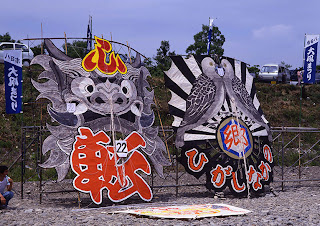Devilman
Devilman (デビルマン Debiruman) is a Japanese manga series written and illustrated by Go Nagai which originally started as an anime adaptation of the concept of Nagai's previous manga series, Demon Lord Dante. A 39 episode anime series was developed by Toei in 1972 and Nagai began Devilman as a manga in Kodansha's Weekly Shōnen Magazine,
barely a month before the anime series started.
The series has since spawned numerous OVAs, manga, novels, and films.
Devilman and other characters from the series have shown up in cameo
appearances numerous times in Go Nagai's other works.
The most notable is Tomoharu Katsumata's 1973 feature film Mazinger Z Vs. Devilman, which features Devilman teaming up with Nagai's titular robot to fight Dr. Hell.
Plot
Devilman is about a teenager named Akira Fudo. At first, Akira is very shy, modest and gentle, trying to avoid conflict. When his parents are lost on a business trip in the Arctic, Akira goes to stay with his childhood friend Miki Makimura and her family (mother, father, and bratty kid brother Tare). Both soon form a close relationship. Miki, a tough, smart, self-sufficient girl, loves Akira but wishes that he would stand up for himself when he gets pushed around, and is frustrated by his lack of backbone. She often has to defend herself from bullies even when Akira is with her. In the first OVA, she saves Akira from a gang of bullies who are threatening him.
One day, Akira's best friend, Ryo Asuka, asks a favor and completely changes Akira's life. Ryo's father had discovered the existence of demons when he found a mask during an excavation of the ruins of an ancient Mayan temple. This mask turns out to be a fossilized demon skull, which shows whomever wore it what the world was like when demons ruled over it. Ryo shows Akira this and informs him about the demons' revival. Akira then sees Ryo's plan: "To fight a demon, one must become a demon."
Demons have the ability to possess and control humans. However, Ryo believes that people like Akira may be able to harness a demon's powers when possessed, due to the fact that Akira has a pure heart. Ryo takes his friend to a nightclub and picks a fight to draw demonic attention to the club. Demons possess the clubbers and threaten Ryo and Akira, until a demon known as Amon the Lord of War, also called the Beast of Hell, and also one of the strongest demons attempts to possess Akira. However Akira manages to gain the upper hand of the possessing process with Amon and transforms into Devilman. Devilman contains the strength and power of the demon Amon, as well as the heart and soul of Akira, giving Akira complete control.
After he becomes Devilman, Akira is no longer timid and shy. He becomes very aggressive and no longer lets anyone push him around. This change pleases Miki, although she is unaware of Akira's new-found powers.
Throughout the series, Devilman has many battles with the demon hordes. He encounters many foes such as Sirène the demon bird, the water demon Geruma, and a large turtle-like demon called Jinmen.
In the manga, the story ends with Akira is revealed by Ryo on a TV broadcast to be Devilman, yet the Makimura's still accept Akira as their friend. Akira then confronts Ryo and discovers that his friend Ryo is really Satan in a dormant state. Satan reveals to Akira that he convinced Akira to become Devilman in order to survive in the world he was planning to create. After Miki and her whole family are brutally slain by a paranoid human horde (in a particularly famous scene, Akira retrieves Miki's dismembered body from her burned house and later is seen holding her head in his arms), Akira states that he has no one left to protect, thus has no reason to exist except to have his final fight with Satan. Satan reveals that he has fallen in love with Akira and is a hermaphrodite. The final fight between Devilman and Satan and his armies ensues. The Earth is totally destroyed during this battle, and Devilman dies at the hands of a regretful Satan, who revealed their reason for defying God was because that even though God created demons, he wished to destroy them. Satan was appaled at this, believing that even though demons were a violent, bloodthirsty race, they still had a right to live, so they joined the demons. While they explain this to a dying Akira, they realized in the end, they were no better than God.
The 1972 anime TV series has no such apocalyptic conclusion and the ending is happier for Akira and Miki than in the manga. Devilman's identity as a real demon is exposed to Miki in the final episode, but she accepts that she is in love with Devilman, even if he is not human.






















































